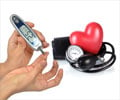World Diabetes Day is an opportune time to evaluate the support available to the estimated 200 million people across the world coping with a galloping disease.

Diabetes is known to crawl in like a silent intruder, so it is better to be forewarned about its predilection. The key risk factors for diabetes include a strong family history of the disease that increases the chances of suffering the disease. Additionally, reduced physical activity, over weight, poor diet, ageing, or high blood pressure, and high blood levels of triglycerides, are positive risk factors. Women with gestational diabetes or diabetes during pregnancy are prone to suffering diabetes later in life. Diabetes seems to have a fond preference for certain ethnic groups - African-Americans, Hispanic-Americans, and Native Americans are highly susceptible to its onslaught.
Type 1 diabetes is labeled an auto-immune disease, where in the victim’s own immune system wipes out the insulin-secreting beta cells in the pancreas. Also called as juvenile-onset diabetes, it afflicts nearly 10-15% of people suffering the disease.
Type 2 diabetes is rather infamous and a common form of diabetes, affecting 85-90% of all people with the disease. Also called as late-onset diabetes, it is typified by insulin resistance and comparative insulin insufficiency. But lifestyle influences can make or mar a potential diabetic. Excess weight, inactivity, high blood pressure and poor diet are major risk factors for its development. This type of diabetes is tricky as symptoms may not really manifest for many years and by the time it surfaces, damage has already begun. People with Type 2 diabetes are twice as likely to suffer cardiovascular disease.
Gestational diabetes mellitus or GDM, also known as carbohydrate intolerance, is detected during pregnancy. Risk factors for GDM are clearly, family history of diabetes, increasing maternal age, overweight or being part of an ethnic group predisposed to the risk. After birth of the baby, the sugar levels return to normal, but the mother and the baby are prone to the risk later on in life. Type 2 diabetes can be really tricky as it may not throw up any symptoms. What is worse, the symptoms may seem a trifle insignificant, and can actually escape attention. In the United States alone, more than 5 million Americans actually suffer Type 2 diabetes but do not know it. However some symptoms could be, increased thirst, increased hunger, and frequent urination, especially at night or weight loss. In some cases, people may experience blurred vision or wounds which don’t heal.
Diabetes management is not all that daunting if people could just pack in about 30 minutes of moderate physical activity in a day, and additionally a 5-10% reduction in body weight. Exercise is very crucial to the management of diabetes. Both types of diabetes can be greatly improved with a regular moderate exercise program as this is the only method to decrease body fat and enhance insulin sensitivity. Exercisers are less likely to develop Type 2 diabetes. Further, Type 1 diabetics who exercise require less insulin. Aerobic activities such as brisk walking, running, cycling, and swimming positively impact blood-sugar levels. By far, this method is capable of bringing down the disease by almost 58%. It is imperative for people who are over weight to slim down. Excess fat causes a shortfall in the number of insulin receptors available in the body, a condition that is detrimental for diabetes.
Source-Medindia











